Coronation 28 April 1730 Name Anna Russia | Predecessor Peter II | |
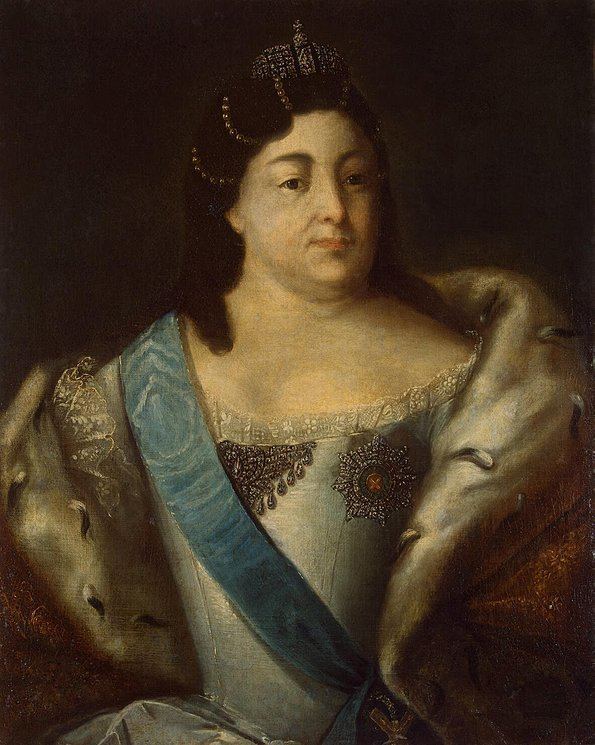 | ||
Reign 30 January 1730 – 28 October 1740 Born 7 February 1693Moscow ( 1693-02-07 ) Burial Peter and Paul Cathedral Role Former Emperor of All Russia Parents Ivan V of Russia, Praskovia Saltykova Cousins Elizabeth of Russia, Grand Duchess Anna Petr, Alexei Petrovich - Tsarevich, Peter Petrovich, Grand Duchess Natalia P Similar People Elizabeth of Russia, Catherine I of Russia, Peter II of Russia, Peter III of Russia, Peter the Great | ||
The life and death of anna of russia
Anna Ioannovna (Russian: anna Ioannovna; 7 February [O.S. 28 January] 1693 – 28 October [O.S. 17 October] 1740), also spelled Anna Ivanovna and sometimes anglicized as Anne, was regent of the duchy of Courland from 1711 until 1730 and then ruled as empress of Russia from 1730 to 1740.
Contents
- The life and death of anna of russia
- Early life
- Accession
- Cadet Corps
- Academy of Science
- The Secret Office of Investigation
- Nobility
- Foreign affairs
- Relationship with Biron
- Westernization
- Death and succession
- Legacy
- References
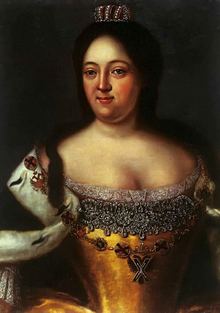
Early life
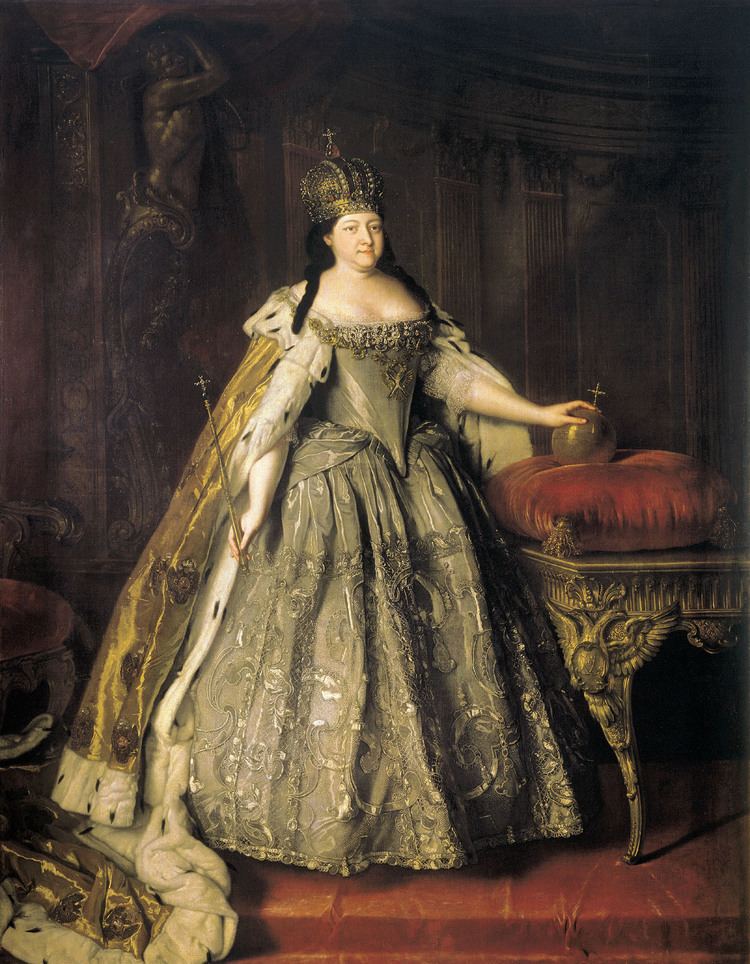
Anna was born in Moscow as the daughter of Tsar Ivan V—the mentally-disabled brother of Peter the Great—and of Praskovia Saltykova. She was primarily raised by her mother, a very stern woman. By Praskovia's orders Anna was to be raised for the nunnery; she grew up confined to a royal cult of domesticity. This type of confinement was known to not allow for development of personality and explains the cruel tendencies of Anna, who followed in her mother's footsteps. Her education consisted of French, German, dancing, religious text, and folklore. As she grew older she proved obstinate, with a mean streak, earning her the nickname "Ivan the Terrible". Her family moved to St. Petersburg by order of Tsar Peter the Great, and this had a significant effect on Anna; she enjoyed the grandeur society.
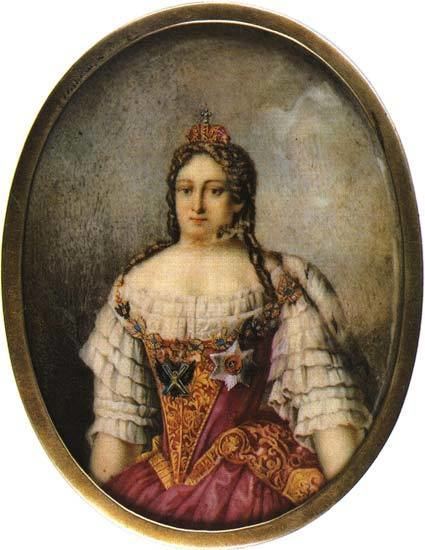
Peter the Great also arranged her marriage to Frederick William, Duke of Courland in November 1710. With her dowry of 200,000 roubles, Anna wed in a grand affair. Two dwarfs performed a parody of the wedding by jumping out of pies immediately following the ceremony. Just a few short weeks after the marriage and only twenty miles out of St. Petersburg on the road to Courland, Duke Frederick died. The cause of death was uncertain - attributed to a chill or to the effects of alcohol.
Accession

After her husband died. Anna proceeded to rule Courland (now western Latvia) from 1711 to 1730, with the Russian resident, Peter Bestuzhev, as her adviser (and sometimes lover). She never remarried after the death of her husband, but her enemies said she conducted a love affair with Ernst Johann von Biron for many years.

On the death of Peter II, Emperor of Russia, the Russian Supreme Privy Council under Prince Dmitri Golitzyn made Anna Empress in 1730. The Council had hoped that she would feel indebted to the nobles and remain a figurehead at best, and malleable at worst. The Council convinced her to sign "Conditions" to her accession—modeled after the Swedes'—that stated she was to govern according to their counsel and was not permitted to start war, call for peace, create new taxes, or name high officials without their consent. She could not punish nobility without trial, could not grant estates or villages, could not promote anyone, either foreigners or Russians, to court office, and she could not spend the revenue generated by the state. A separate party rose against the families of the princes Dolgorouki and Galitzin who composed the counsel, petitioning the empress to assume the autocracy of her predecessors. Anna dissolved the Privy Council, exiling some of the framers of the constitution to Siberia and sending others to the scaffold.
Cadet Corps
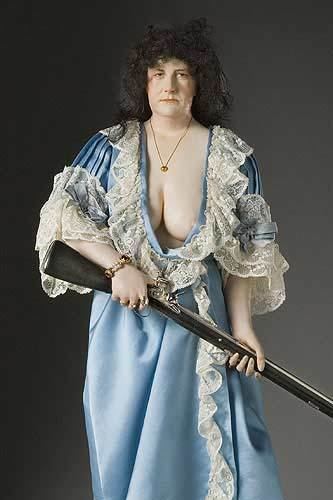
Anna founded the Cadet Corps in 1731, one year after coming to the throne. The Cadet Corps was a group of young boys starting at the age of eight being trained for the military. There was a very rigorous training program and this also included all the schooling that was necessary for someone to be in an important position in the military. As time went on though, the program was later improved by other emperors and empresses, such as Catherine the Great. They began to include the arts and sciences into their schooling, rather than just the knowledge that is considered necessary for only a career in the military.
Academy of Science
Started by Peter the Great, Anna continued to fund the Academy of Science. The point of this school was to further the sciences in Russia and to help bring the country that was so far behind up to where the Western Countries were. Some of the sciences that were taught were mathematics, astronomy, and botany. The Academy of Science was also responsible for a lot of the expeditions, specifically to the Bering Sea. The Bering Sea Expedition is one of the more famous ones that was done by the Academy of Science. While they were trying to find out if America and Asia had been at one point connected, they also studied Siberia and its people, these studies were used long after they returned from Siberia. But there were also some troubles for the scientists. Oftentimes, the government and the church would meddle in their funding and their experiments, changing the data to how they wanted to see it. This school of science was very small, never exceeding a population of twelve students in the university and barely over a hundred in the secondary school. But still it was a huge step forward for education in Russia. Many of the teachers and professors were imported from Germany bringing more of a Western feeling to what the students were learning about. Some of the students to learn from these German professors later became advisors or teachers to some of the future leaders, such as Catherine the Great’s tutor, Adodurov. During Anna’s reign, the Academy of Science began to include the Arts into their program. For not only was there not a school for the arts yet, but Anna was a firm supporter of the arts. Theater, architecture, engraving, and journalism were all added to the curriculum. During this time, the foundations of what is now the world famous Russian Ballet was laid down as well.
The Secret Office of Investigation
There have been many rumors since the time of Anna’s reign that Biron had a large impact on this office, but truly it was run by the senator A. I. Ushakov. This office was resurrected during Anna’s reign to punish those for political crimes mostly, but sometimes they would take cases that were not as political. The punishments that came from the crimes that were committed, were often very painful and disgusting. For example, some people that had supposedly been plotting against the government had their noses slit as well as being beaten with the knout. Russian authorities listed a total of around 20,000 Russians—including some of the highest native nobility—fell victim to Biron and Anna's police.
Nobility
There is a lot of mention of Germans throughout the reign of Anna. For example, she often gave them ruling positions in her cabinet and other important decision making positions. This was because she had very little trust in the Russians. It was because of this strong German influence in government that many Russians came to resent them. Anna gave many privileges to those that were considered the nobility. In 1730, she made sure that the law of Peter the Great outlawed states from being subdivided, the primogeniture law, was repealed. Starting in 1731, landlords were responsible for their serfs' taxes and their economic bondage was tightened again. In 1736, when the age of service changed to twenty with a twenty-five year service time, Anna and her government also determined that if the family had more than one son, one could stay behind so that he could work the estate.
Foreign affairs
During Anna’s reign, Russia became involved in two major conflicts, the War of the Polish Succession and the Turkish wars. In the former, Russia worked with Austria to support Augustus II's son Augustus against the candidacy of Stanislaw Leszczynski, who was dependent on the French and amiable with Sweden and Turkey. Russia's involvement with the conflict was quickly over, however, and the 1736–39 Crimean War was much more important.
In 1732, Nader Shah had forced Russia to return parts of the lands in the Northern and Southern Caucasus and in northern mainland Persia that had been taken during Peter the Great's Russo-Persian War; this Treaty of Resht permitted an alliance against the Ottoman Empire and, in any case, the provinces of Shirvan, Ghilan, and Mazanderan had been a net drain on the imperial treasury for the entirety of their occupation. Three years later in 1735, conforming to the Treaty of Ganja, all the rest of the territories taken more than a decade earlier from Persia in the North and South Caucasus were returned.
The war against the Turks took four and a half years, a hundred thousand men, and millions of rubles; its burdens caused great stress on the people of Russia; and it only gained Russia the city of Azov and its environs. Its effects, however, were greater than they first appeared. Osterman's policy of southern expansion prevailed over the 1711 Peace of Pruth signed by Peter the Great; Munnich had given Russia its first campaign against Turkey that had not ended in crushing disaster and dissipated the illusion of Ottoman invincibility; he had further shown that Russia's grenadiers and hussars could defeat twice their number of janissaries and spahis. The Tatar hordes of the Crimea had been exterminated and Russia's signal and unexpected successes greatly increased its prestige within Europe.
The Russians also established a protectorate over the khan of the Kirghiz, sending officers to assist his short-lived conquest of Khiva.
A Chinese embassy to her court at St Petersburg was the only one ever dispatched to Europe through the late 19th century.
Relationship with Biron
Anna’s reign is often referred to as “The Age of Biron” (Bironovschina), after her German lover Ernest Johann Biron. What separates Anna’s reign from the majority of imperial Russian history is the fact that her courts were almost entirely made up of foreigners, and the majority of whom were German. Historians isolate her rule from Russian history due to long-term prejudice towards Germans. Historians would also argue that Biron not only had a strong influence on Anna’s domestic and foreign policies, but that he also reigned solely at times. Anna was attracted to Biron’s charm and he proved to be a good companion to her after her tragic past love life. But Biron’s name became synonymous with cruelty, terror, and evil, ensuring Anna’s reign with a dark mark. Anna never remarried; as empress of Russia she enjoyed the power she held over all men and viewed marriage as unnecessary.
Westernization
Anna continued lavish architectural advances in St. Petersburg. Anna completed a waterway that began construction under Peter the Great and called for seafaring ships to accompany this new canal and continue naval expansion. Westernization continued after Peter the Great’s reign in areas of prominent Western culture such as the Academy of Science, cadet corps education, and imperial culture including theater and opera. Although not at the fast-paced speed of Westernization under her Uncle Peter’s reign, it is evident that a culture of the expansion of knowledge continued during Anna’s rule and affected mostly nobility. It is argued that this success in Westernization is due to the efforts of the German court nobility; the foreigners’ impacts are viewed both positively and negatively.
Death and succession
Anna was famed for her big cheek, "which, as shown in her portraits", Carlyle says, "was comparable to a Westphalian ham". As her health declined she declared her grandnephew, Ivan VI, should succeed her, and appointed Biron as regent. This was an attempt to secure the line of her father, Ivan V, and exclude descendants of Peter the Great from inheriting the throne. It was recorded she had an ulcer on her kidneys. She continued having attacks of gout, and as her condition worsened, her health began to fail. Anna died on October 17, 1740, from a terrible kidney stone that made for a slow and painful death. The tsaritsa’s final words focused on Biron. Anna died at the age of 47 of kidney disease. Ivan VI was only a one-year-old baby at the time and his mother, Anna Leopoldovna, was detested for her German counsellors and relations. As a consequence, shortly after Anna's death Elizabeth Petrovna, Peter I's legitimized daughter, managed to gain the favor of the populace, locked Ivan VI in a dungeon, and exiled his mother. Anna was buried three months later on January 15, 1741, leaving behind uncertainty for the future of Russia.
Legacy
In the West, Anna's reign was traditionally looked on as a continuation of the transition from the old Muscovy ways to the European court envisioned by Peter the Great. Her government, on the whole, was prudent, beneficial and even glorious; but it was undoubtedly severe and became at last universally unpopular. Within Russia, Anna's reign is often referred to as a “dark era”. The issue with Anna’s reign derives from her personality flaws. Even considering the need of Russian rulers to avoid displays of weakness, Anna's rule involved questionable acts towards her subjects. She was known to enjoy hunting animals from the palace windows and on more than a few occasions humiliated individuals with disabilities. There were continued issues with serfdom, peasant and low class slavery, taxation, dishonesty, and rule through constant fear. Her empire was described by Lefort, the Saxon minister, as being “comparable to a storm-threatened ship, manned by a pilot and crew who are all drunk or asleep. . . with no considerable future.” Anna’s war with Turkey, economic issues, and conspiracy revolving around her accession all bring to light an ominous glow of the empress’s reign. She restored the courts in St. Petersburg and brought Russia’s political atmosphere back to where Peter the Great had intended progress; the grandeur was almost unmatched in Europe or Asia; but such lavish court life was overshadowed by the thousands of men slaughtered in war. It is undeniable she had a vast impact in science and culture, but it came with a price. The positive aspects of Anna’s reign are typically ignored, though it is important to note that she had no more influence on domestic and foreign relations and policies than any other 18th-century ruler.
